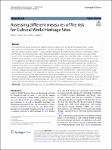Item Infomation
Full metadata record
| DC Field | Value | Language |
|---|---|---|
| dc.contributor.author | Falk, Martin Thomas | - |
| dc.contributor.author | Hagsten, Eva | - |
| dc.date.accessioned | 2023-09-15T02:43:18Z | - |
| dc.date.available | 2023-09-15T02:43:18Z | - |
| dc.date.issued | 2023 | - |
| dc.identifier.uri | https://link.springer.com/article/10.1186/s40494-023-01026-y | - |
| dc.identifier.uri | https://dlib.phenikaa-uni.edu.vn/handle/PNK/9031 | - |
| dc.description | CC-BY | vi |
| dc.description.abstract | This study aims to assess whether two publicly available sources of fire threats to 346 Cultural World Heritage Sites across Europe substitute or complement each other. By doing so, a novel measure based on information from the UNESCO periodic report II is created and benchmarked against the European forest fire information system (EFFIS) index. The UNESCO periodic report shows that forest fires are perceived as an actual or foreseeable hazard by 40% of the management of Cultural World Heritage Sites in Europe. When the EFFIS index is linked to the UNESCO World Heritage database, it occurs that 48% of these sites are at high risk of fire, 31% at medium risk and 21% at low risk. Results based on Probit and Fractional Probit estimations reveal that the perceived fire risk relates to several site characteristics as well as location. | vi |
| dc.language.iso | en | vi |
| dc.publisher | Springer | vi |
| dc.subject | EFFIS | vi |
| dc.title | Assessing different measures of fire risk for Cultural World Heritage Sites | vi |
| dc.type | Book | vi |
| Appears in Collections | ||
| OER - Khoa học Vật liệu, Ứng dụng | ||
Files in This Item:

